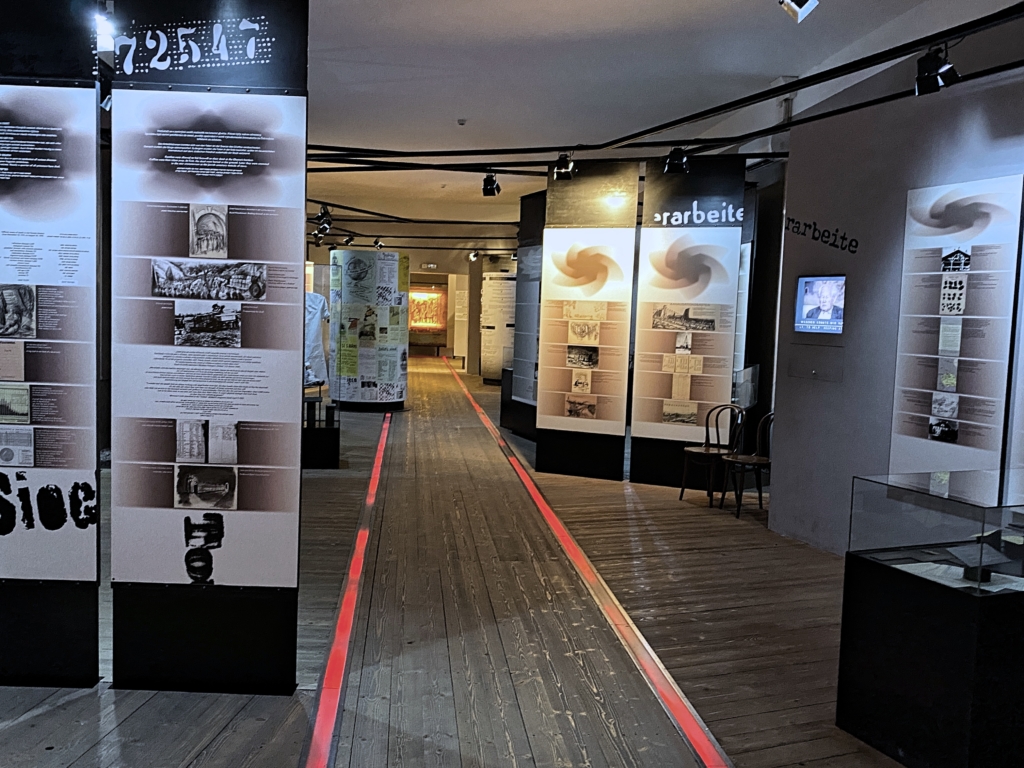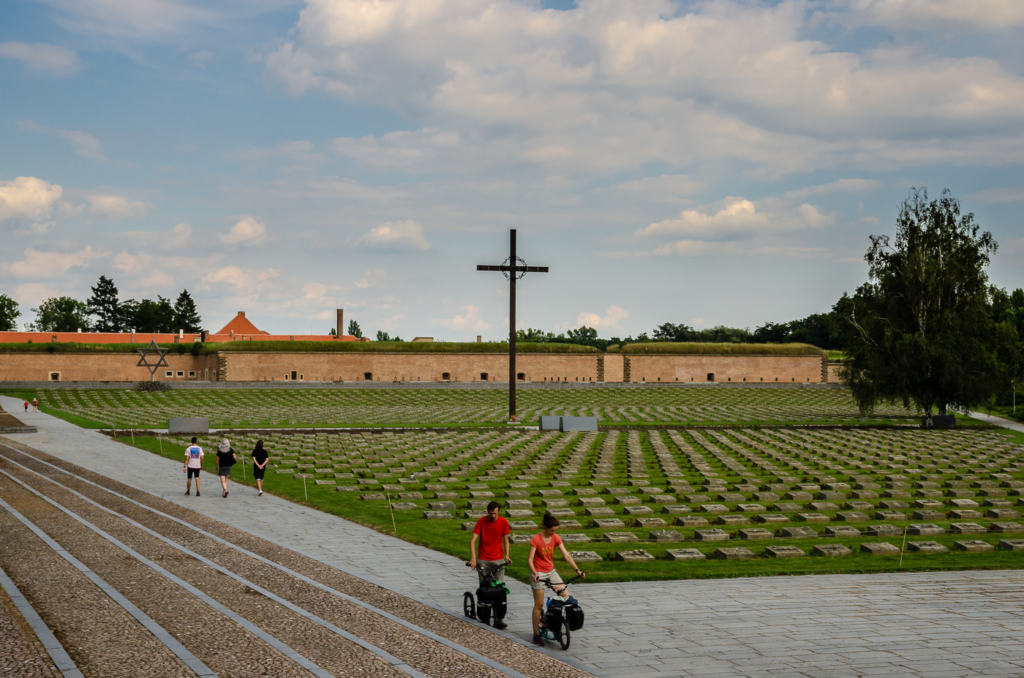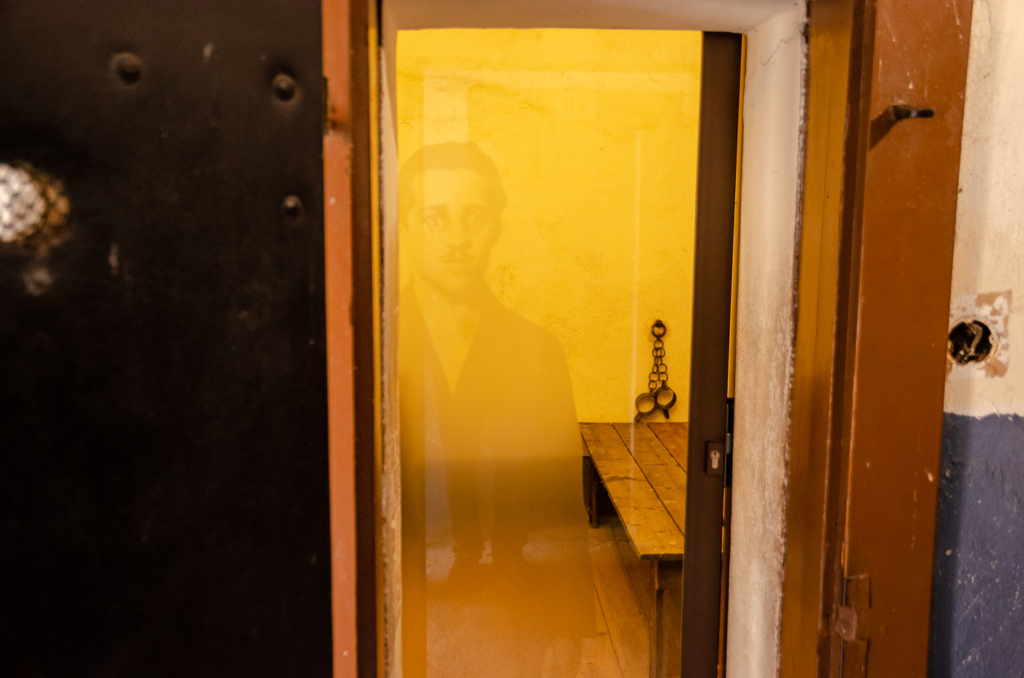Terezín is a small city in the western Czech Republic, roughly halfway between Prague and the German border on the way to Dresden. It was a unique site in the deplorable Nazi network of concentration camps and ghettos. The Terezín Memorial was established in 1945 and now has several locations in the town.
The Nazis took over Terezín, relocated the residents and forced in Jews, initially from the current Czech Republic, then others from Nazi-occupied lands. Deceptably, they called it a retirement community for Jewish senior citizens, many of whom were prominent in the arts, business and science, and invalids of WWI. Unknown to the relocated Jews, it was a holding site before transfering them to death camps. During WWII over 130,000 were sent here and only 17,000 were alive here at the end. The Nazis had granted a modicum of self-government to the Jewish inhabitants (in the midst of deplorable living and work conditions), including self-expression though arts, to be more efficient in their control of the population. They also brazenly used Terezín for propaganda purposes to deceive the outside world about the terror they were inflicting.
Why We Went to Terezín?
In August and September 2021, my wife Khadija and I went on a five-week drive through Eastern Europe and visited many of the great cities of the region. We left Prague on the way to Dresden and decided to stop at Terezín because of its historical significance. We spent three-hours there, learning about the site’s grim history. While it was depressing, it was worth it in order to know the evil spread by the Nazis, which hopefully will never be repeated anywhere in the world.

As you can see in the map, the memorial is spread throughout the city. We went to the Ghetto Museum, the National Cemetery and the Small Fortress. To see everything would take at least another two hours. The Terezín Memorial explains the significance of all the locations.
Is Terezín Safe?
In a word, yes. One somewhat relevant example, cross-country bikers go through here on a daily basis.

Here, as everywhere you travel, employ basic safety precautions and use common sense to avoid problems
Is Terezín Memorial Expensive?
A visit is inexpensive. We paid Kč 170 / person (US$7.80) for a combined admission to the Ghetto Museum and the Small Fortress. In both places, we had to use some coins for parking. We stopped at the Restaurant Atypik by the Ghetto Museum and spent about Kč 100 (US$4.60) for cappuccinos and delicious pastries.
How to Get Around in Terezín
We drove between the Ghetto Museum and the Small Fortress. It would be a long walk but a short bike ride. The Crematorium is away from the city center.
Ghetto Museum
The Ghetto Museum is the best place to understand the history of this notorious period in Terezín. The pictures in this section are from there.

The museum is a former two-floor school and is filled with informative exhibits.

Under the Nazi leadership, Germany passed the Nuremberg Laws in 1935, which established a second-class citizenship for Jews, including prohibition of marriage with other “races”. In 1938, the Nazis annexed the Sudetenland (northern, western and southern stripes of Czechoslovakia), claiming it was part of Greater Germany, because most of the population was German. In 1939, they invaded Bohemia and Moravia (the rest of the current Czech Republic) and established a Protectorate. All citizens in the Protectorate lost rights, but especially the Jews. Their property was confiscated and their contact with non-Jews was severely restricted. In 1941, Jews were required to wear in public the yellow star of David.

In 1942, the inhabitants were forced to leave and Terezín became a complete ghetto (an area in which Jews were formerly required to live, without other ethnic groups, in subservient and callous standards).
The Jews were allowed to bring limited possessions which they could carry, most of which were mostly confisicated when they arrived.

Eventually over 150,000 would pass through Terezín. Women and children were separated from men and all lived in terribly crowded conditions where disease was rampant. While staying there, most would be incorporated into extreme forced labor in farms and factories and fed barely enough to stay alive. If they didn’t die in these unforgiving conditions, they were eventually shipped east to death camps such as Auschwitz – Birkenau.
The Nazis authorized a Jewish Council of Elders to run the internal affairs of the ghetto, under the harsh rules which severely limited their autonomy. The Nazis did this as an efficiency measure and to give the world a wholly inaccurate impression of the nature of the settlement. Nevertheless, the residents did their best to survive under appalling conditions by educating children and promoting the arts. Here’s a poem written by a young boy.

While the residents may not have known exactly their fate, they knew that their demise was likely.
The children’s poetry, drawings, journals, diaries and other items which survived provide a great deal of information to historians and journalists on the interworking of the ghetto.
In the field of music, there were prominent composers and musicians who taught music to children and assembled an orchestra, who performed symphonies and operas. The Nazis used these limited freedoms for propaganda purposes, as there was constant international pressure to let the Red Cross inspect the camps. The Nazis decided to let an international delegation make a single visit in 1944, but first spent months making several improvements so they could claim this was a “spa” for Jews. When the delegation arrived, they witnessed a purportedly-regularly scheduled soccer game and ironically a performance of Verdi’s Requiem. The Nazis had the advantage that most of the population had been shipped off, so it was easier to pull off this charade. Disappointingly, they were somewhat successful in hoodwinking the delegation, though detractors vehemently criticized the delegation’s report.
The last transport of Jews east was in October 1944. On May 5, 1945, Nazis left Terezín while thousands of nearly dead prisoners from the east arrived bringing typhus, which spread throughout the population. A few days later the Red Army liberated the camp and started providing medical care and the whole city became a field hospital. This effort saved thousands.
In October 1945, the original residents were allowed to return.
National Cemetery
The Terezín National Cemetery is in front of the Small Fortress.The vast majority of the buried are Jews, but there are others including prisoners held in the Small Fortress and Allied soldiers.
The cemetery has over 2,300 individual graves for those exhumed from mass graves in Terezín and Litoměřice, a nearby forced labor camp. The graves have numbers and sometimes the names and dates of birth or death.

The cemetery has a large Christian Cross and the Star of David.

About 8,000 are also buried in a mass grave marked with a stone stele.
Small Fortress
Terezín Fortress, a sprawling complex with multiple walls and berms, was created in the 1880s by the Hapsburg Empire for their wars with Prussia, although no battles occurred here.

The part known as the Small Fortress served as a prison for military and political convicts, including Serbian nationalist Gavrilo Princip, assassin of Archduke Franz Ferdinand of Austria, who died there of tuberculosis four years later.
The Nazis used the Small Fortress as a Gestapo prison for “criminals” in the Terezín Ghetto, Allied prisoners of war and “dissidents” from occupied lands. The entrance is in a long brick wall (shown from the inside).

The structure has a number of blocks where prisoners were put in overcrowded cells. For instance, ten or more had to sleep in one bed (the section between the vertical slats).

There were solitary confinement cells, complete with handcuffs on the wall. As pictured, one now-glass door has an image of one of the prisoners.

On one interior gate, there’s black lettering with the Nazi slogan “work makes you free.” I wonder why they would make the effort of painting this.

Walking around here, one can image tortured, starved and diseased inmates struggling to stay alive.
There are periodic tours given, but when we were there, none were in English. We bought a cheap map and walked on our own through the facility.
Crematorium
We didn’t go to the Crematorium, but I want to say a few words about it. Approximately 30,000 died in Terezín for many reasons, including physical abuse, exhaustion, and disease. However, they were not mass killed in gas chambers. The Nazis used cremation to deal with the thousands of dead bodies. Starting in 1944, the Crematorium also burned dead bodies from the Litoměřice forced labor camp until it had its own crematorium in April 1945.
The Crematorium was built by Jewish prisoners starting in 1942. A corpse was placed in the incinerators on a board, often a coffin lid. Prisoner-workers attempted to put the ashes of each person into an urn.
They also had to pick out fragments of gold and dentures, which the Nazis used in their war machine. The Nazi kept cremation records on each person (again I wonder why they would put the effort in doing this). Urns were transported to the Columbarium (a room or building for storing funeral urns). The Nazis were creating an impression for the prisoners’ benefit that the remains would receive proper burial after the war. In late 1944, the Nazis knew they were likely to lose the war and scrambled to coverup their evil practices by ordering prisoners to dispose of the urns. About 3,000 urns were buried in Litoměřice and about 22,000 were emptied into the Ohře River. Later the urns were burned.
Final Thoughts
For those who want to get a thorough, but succinct, description of what happened in Terezín during WWII, I suggest purchasing The Terezín Ghetto by Ludmila Chladkova.
Terezín has other museums on subjects other than WWII, such as the Museum of Nostalgy, an exhibition of things from the socialist era of the country. It’s also a very nice city to walk in and has a large, well-maintained central square, surrounded by Neoclassical and other styles of buildings.

Usually my travels are fun and exciting, but this experience was learning about a horrific time in humanity’s history. While hard to witness and contemplate, it’s important for the world to remember what can happen when dark forces prevail.


